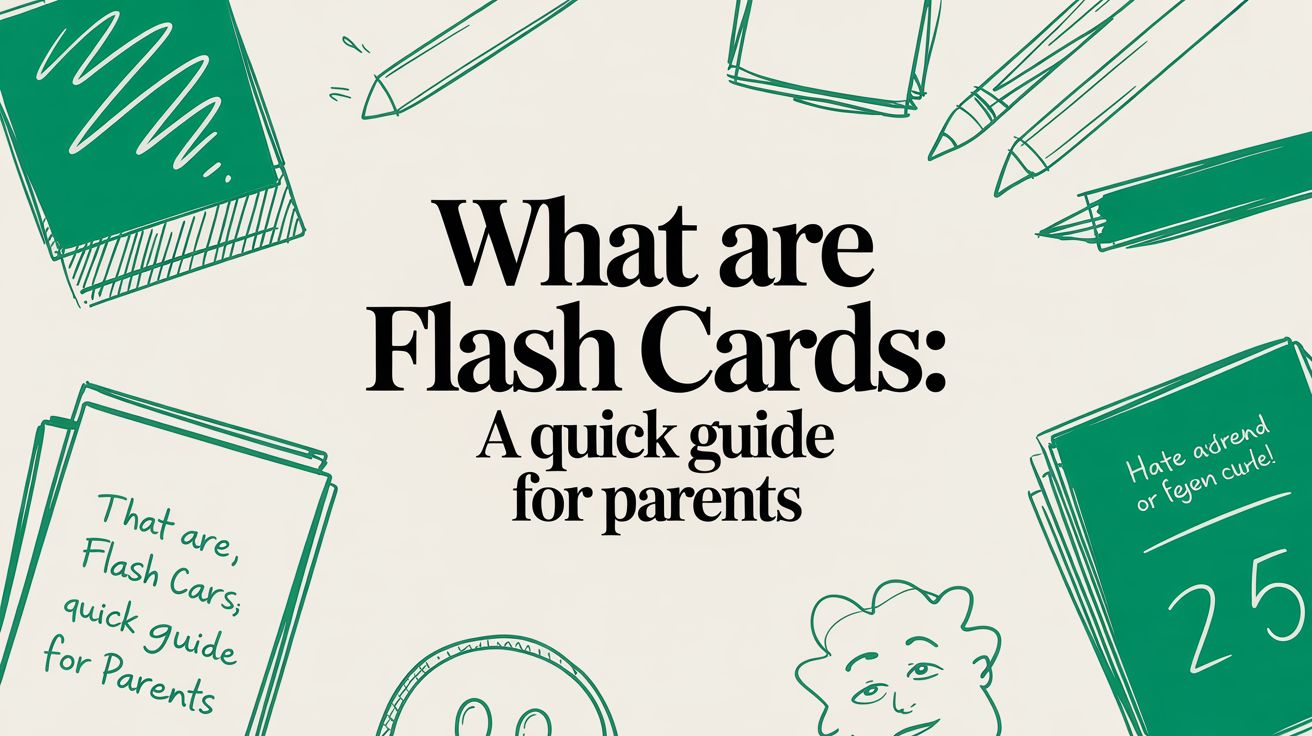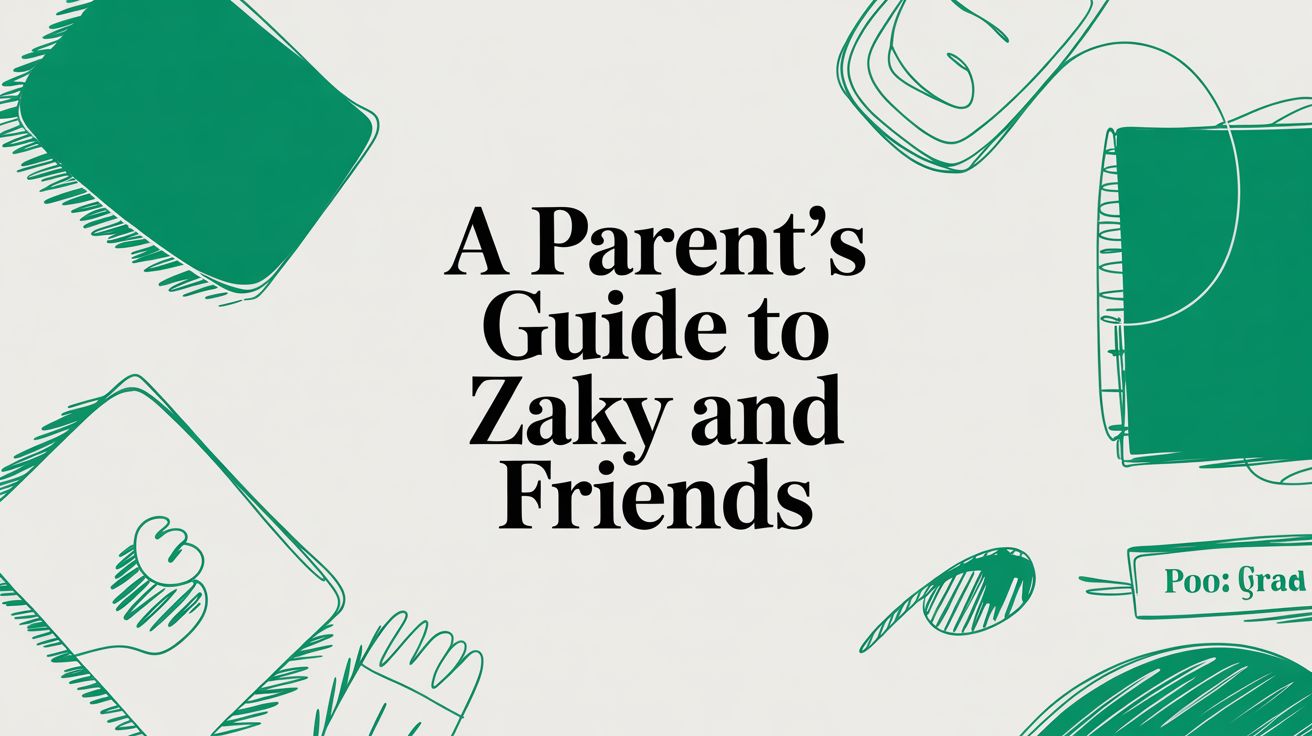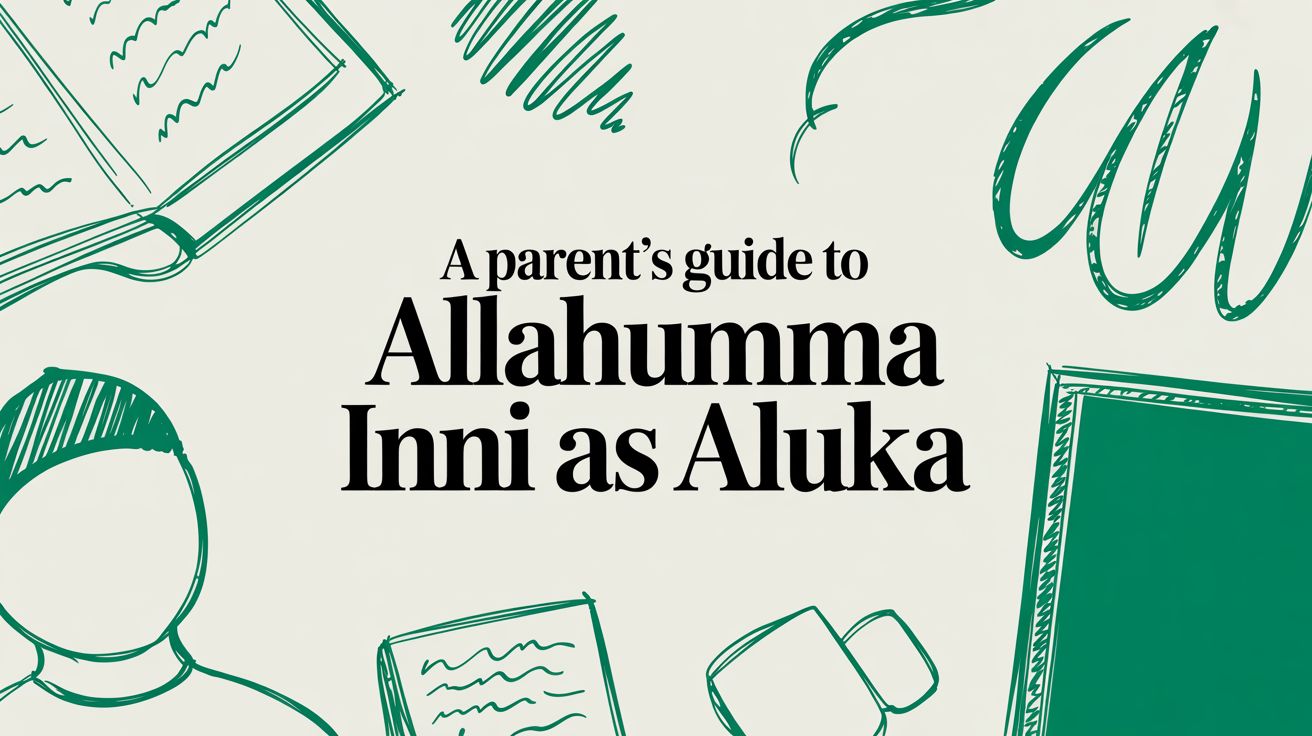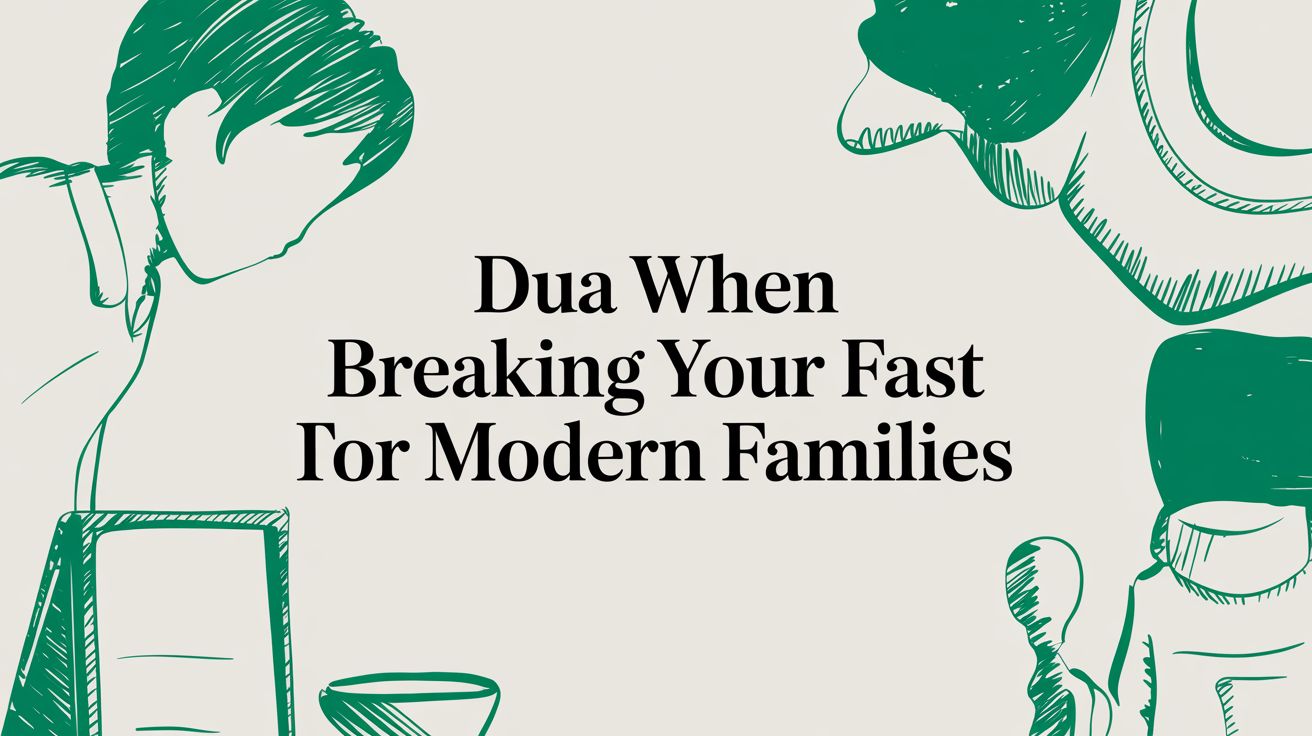At their heart, flash cards are simple, powerful learning tools that break down information into small, manageable chunks. Think of them as bite-sized learning prompts, often with a picture or question on one side and the answer on the other. They’re designed to make practicing and remembering key facts quick and, most importantly, effective.
How Do Flash Cards Actually Work?
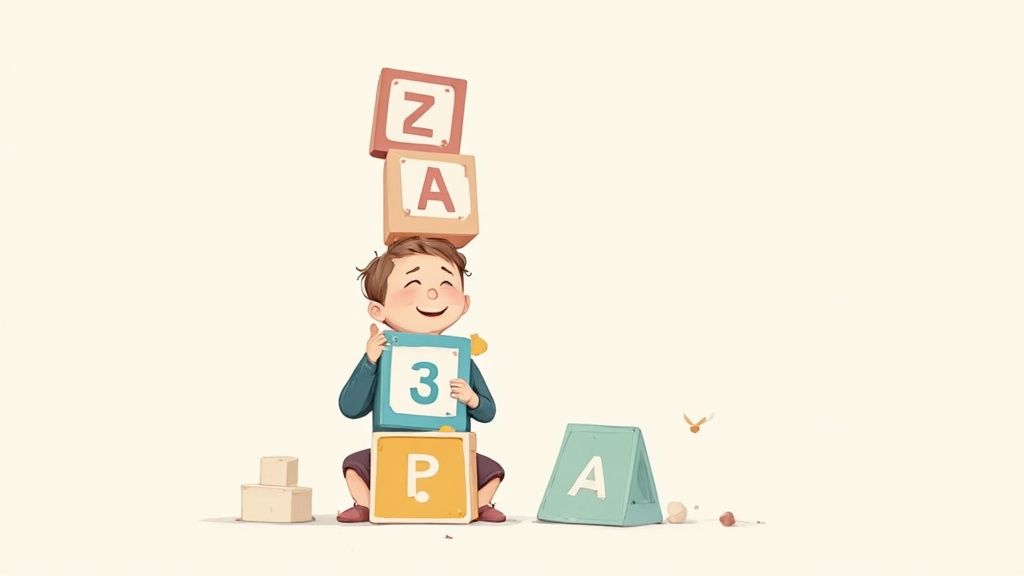
Let's say you want to teach your toddler what an apple is. You could describe it in a long sentence, but that’s a lot for a little one to process. Instead, you show them a card with a picture of a shiny red apple. That simple act of pairing a visual with a word is the magic of a flash card.
This process works because it triggers a mental workout called active recall. Rather than just passively seeing or hearing something, your child’s brain has to actively pull the information from memory. Every time they see the apple and you say the word, their brain works to make that connection.
This effort strengthens the neural pathways responsible for memory. The more they practice, the stronger and faster that connection becomes.
It’s a subtle shift, but it turns learning from a passive activity into an engaging mental exercise. This makes it far more effective for long-term memory than just rereading a book over and over.
The Two Main Flavors of Flash Cards
Flash cards come in two main forms, and each has its own place in your child's learning journey. Knowing the difference can help you pick the right tool for the right moment.
Physical Cards: These are the classic, hold-in-your-hand printed cards. For babies and toddlers, their tactile nature is fantastic. It engages their sense of touch and even helps develop fine motor skills as they try to grasp and hold them.
Digital Cards: These are the modern versions you find in apps and on websites. They often come with fun extras like sounds, animations, and simple games, which can be really captivating for older toddlers who are ready for a bit of guided screen time.
Whether you're using a sturdy cardboard card or a colorful one on a tablet, the core idea is the same: focused, repeated exposure to a single piece of information. This repetition is what helps young minds build a solid foundation of knowledge, from their first colors and shapes to more complex ideas down the road.
The Surprising History of Flash Cards
Flash cards seem like a permanent fixture in modern learning, but their history goes back much further than you might think. The basic idea—using small, portable cards for quick-fire learning—is a classic educational strategy with surprisingly deep roots.
Long before they were mass-produced, people used handwritten notes and cards to memorize information. This simple technique was a game-changer, freeing students from the chains of a heavy textbook and making learning something you could do anywhere.
It wasn't until the 19th century that flash cards as we know them really caught on, aligning perfectly with an educational focus on rote memorization. They became so common that by the early 20th century, the word 'flashcard' had officially earned its spot in the English dictionary. You can dig deeper into the history of flashcards to see just how they've evolved.
From Simple Notes to Learning Powerhouses
As teaching methods grew more sophisticated, so did flash cards. They evolved from being just for words and dates into powerful tools for all kinds of learning.
- Learning to Read: Phonics cards were a breakthrough, pairing a letter with a picture to help a child's brain connect the sound to the symbol.
- Mastering Math: Simple addition and subtraction problems on cards allowed for rapid drills, building the kind of quick-recall math skills that are crucial for confidence.
- Understanding Science: Flash cards made complex topics, like the parts of a plant or the elements on the periodic table, much easier to digest and remember.
The designs have changed and the technology has advanced, but the core principle has stayed the same. The power of focused, repetitive learning is timeless.
This is why flash cards remain a favorite for parents and educators. They are a simple, effective way to introduce new concepts and lock them into memory, proving that sometimes the oldest tools are still the best.
Why Flash Cards Click with Little Brains
Ever wonder what makes a simple stack of cards such a powerful learning tool? It’s not magic; it’s brain science. Flash cards tap directly into the way a child’s mind is naturally wired to absorb information, making learning feel less like a chore and more like a game. The secret sauce is something called active recall.
Think of it this way: passively reading a book to your child is like a gentle stroll for their brain. But when you show them a card with a cat and they have to remember the word "cat," that’s a mental push-up. This act of pulling the information from their memory strengthens the neural pathways, making that memory stick for the long haul.
From a Quick Glance to Lasting Knowledge
Another powerful concept at play is spaced repetition. It sounds technical, but the idea is beautifully simple. Instead of showing your child the same card 50 times in one sitting, you review it at increasing intervals—once today, again in a few days, and then maybe next week.
This timed exposure sends a clear signal to the brain: "This is important stuff, so hang onto it!" It's a much more effective way to build long-term memory than cramming, because it gives their developing brain the time it needs to properly file the information away.
Flash cards make this incredibly easy to do. The cards your little one masters can be put aside for a while, letting you focus more on the ones they're still working on. It creates a natural, customized learning pace just for them.
Finally, flash cards subtly teach a skill called metacognition, which is just a big word for thinking about what you know. When your toddler starts sorting cards into an "I know it!" pile and a "Not yet!" pile, they're actually evaluating their own learning.
This simple act is a huge confidence booster. It reframes learning as a fun challenge—moving cards from the "tricky" pile to the "I did it!" pile—and builds a positive, can-do attitude that will serve them for years to come.
How to Choose the Right Flash Cards
With a sea of options out there, picking the right flash cards can feel a bit overwhelming. The secret is to tune into your child's specific age and what they're ready for. What captivates a one-year-old on the move is very different from what a newborn needs as their vision is just coming into focus.
For the littlest ones, you can't beat good old-fashioned physical cards. There's a special kind of learning that happens when a baby can actually touch, hold, and explore an object with their hands and mouth. That sensory feedback is something a screen just can't offer, and it's fantastic for developing those tiny hand muscles.
Considering Your Child's Age
When you're looking at physical cards, think simple and safe. Your best bet is sets made from non-toxic, chew-proof materials with soft, rounded corners.
For newborns (0-3 months): High-contrast, black-and-white cards are perfect. A baby's vision is still developing, and these bold, simple patterns are some of the first things their eyes can properly focus on. It’s a wonderful way to gently stimulate their visual development.
For infants (4-12 months): Now you can bring in the color! Look for cards with a single, clear picture of something they see every day—a ball, a cup, or even a picture of Mama or Baba. The bright colors grab their attention and start building those very first word associations.
For toddlers (1 year+): As they get bigger and more curious, you can move on to slightly more complex ideas like animals, basic shapes, or even the first few letters. Durability is a must at this stage, since these cards are going to see a lot of action!
The goal isn’t to overwhelm your child but to meet them where they are. A simple, age-appropriate card is far more effective than one that’s too busy or advanced for their current stage.
Once your little one enters toddlerhood, digital flash card apps can be a great addition to their learning toolkit. The interactive nature of apps, with their fun sounds and animations, can turn learning concepts like the Arabic alphabet or numbers into a playful game.
The infographic below shows the science that makes any good flash card work, whether it’s held in their hand or seen on a screen.
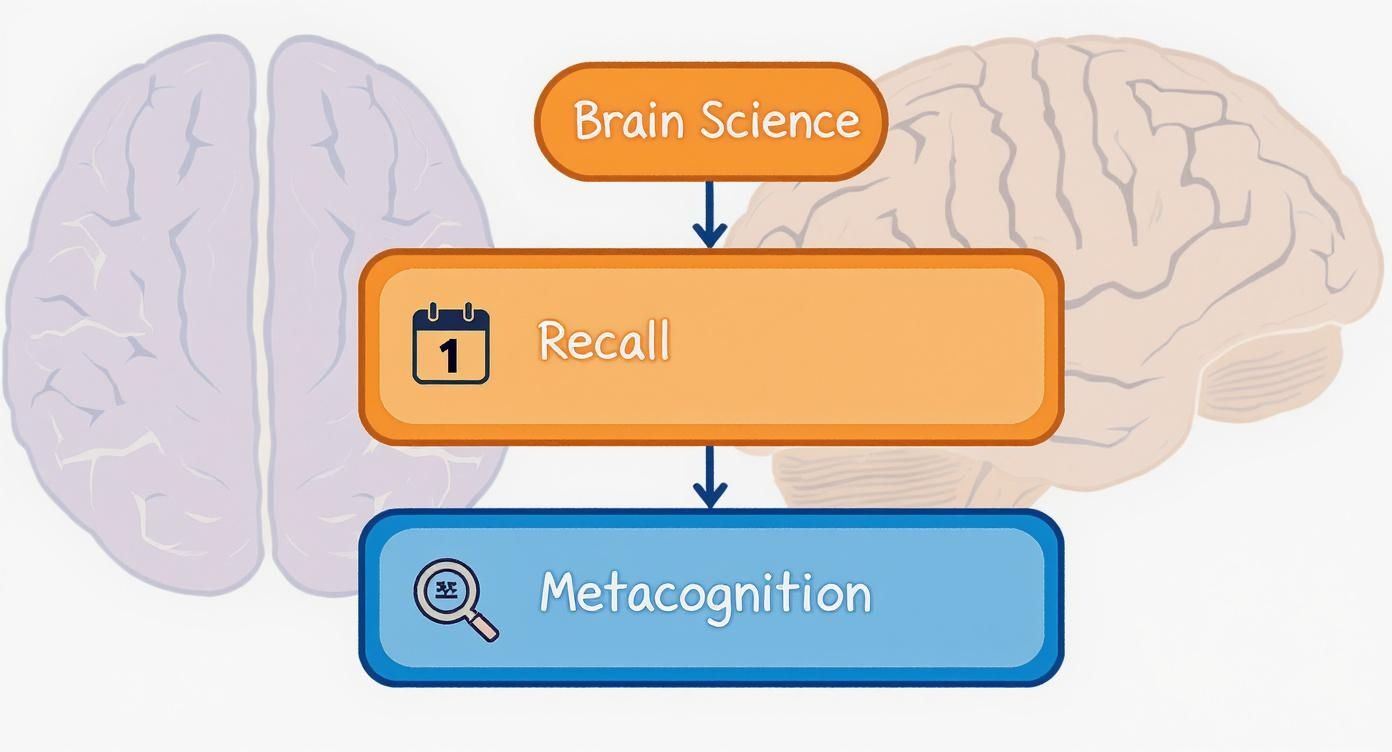
It all comes down to the same powerful principles of recall and repetition. Whether they are touching a card or tapping a screen, the right flash cards make learning an active, hands-on experience that helps build lasting memories.
Making Flash Card Time Fun and Effective

The real magic of flash cards isn't about drilling your child for answers. It's about sparking a playful connection and turning a simple learning tool into a moment of pure joy between the two of you.
The secret? Keep things light, positive, and completely free of pressure. When learning feels like a game, a child’s natural curiosity takes over. This way, they soak up new information without even realizing it, creating a happy foundation for a lifetime of discovery.
Creating a Positive Learning Vibe
Your energy is contagious. If you’re excited and encouraging, your little one will mirror that enthusiasm. It’s all about celebrating their effort and curiosity, not just whether they get an answer "right."
Think of it as creating short, happy memories instead of structured lessons. Here are a few practical tips to keep flash card time genuinely fun:
- Keep It Short and Sweet: A toddler's attention span is short. Aim for just 5 to 10 minutes at a time, and always stop before they start getting fussy.
- Make It a Game: Don't just show the card—bring it to life! Play peek-a-boo with an animal card or make the airplane card "fly" around the room with sound effects.
- Follow Their Cues: If your child is more interested in stacking the cards into a tower than naming the pictures, that's perfectly fine. Let them lead the exploration.
The goal is connection, not correction. When a child feels safe, loved, and happy, their brain is primed for learning.
Integrating Cards into Your Daily Routine
One of the most effective ways to use flash cards is to weave them seamlessly into your day. This small shift makes learning feel relevant and part of their world, not a separate task.
It's all about connecting the picture on the card to a real object or experience. For example, show them the "ball" card just before you head outside to play, then point to the actual ball. Or pull out the "apple" card while you're slicing one up for a snack.
This simple act bridges the gap between a picture and a real-world object, making the concept stick. It turns an abstract image into something they can touch, see, and experience, which is incredibly powerful for their developing mind.
Your Flash Card Questions Answered
Even with something as simple as flash cards, it's natural to have questions. Knowing the right "when" and "how" can make all the difference, helping you feel confident as you bring them into your child's world. Let's walk through some of the most common things parents ask.
When Is a Good Age to Start With Flash Cards?
You can start much earlier than most people realize. For a newborn (0-3 months), simple black-and-white, high-contrast cards are perfect. Their brand-new eyes are still developing, and those bold, clear patterns are some of the very first things they can truly focus on.
Once they reach about 6 months, you can bring in cards with simple, colorful pictures of things they see every day—a ball, a cup, a cat. The real secret is to match the complexity of the card to where your child is developmentally. And always, always keep it short and fun, like a game, not a quiz.
Are Digital Flash Card Apps Okay for Toddlers?
When used the right way, they absolutely can be. A good digital app can be a handy tool to have in your pocket, especially for older toddlers who are naturally drawn to tapping and swiping. Their interactive nature can be a fun addition to physical cards.
The key is to be picky about the app and to stay involved. Look for ad-free apps that offer genuinely educational, age-appropriate content. And remember, screen time is just one small part of their day. It should always be balanced with tons of hands-on play, real-world exploration, and cuddles with you.
Think of digital flash cards as a healthy snack, not the whole meal. They should add variety to a child's learning diet, which must include imaginative play, reading books together, and social connection.
How Often Should We Use Flash Cards?
It’s all about consistency, not cramming. Short, happy daily sessions of just 5-10 minutes are far more effective than a long, drawn-out session once a week. You're aiming for quick bursts of positive interaction.
Try tucking them into a part of your daily routine, maybe for a few minutes after their nap or while they're sitting in their high chair. If your little one starts wiggling away or seems fussy, that’s your cue to stop. The goal is to make learning feel like a joyful and loving activity, right from the start.
Will Flash Cards Actually Make My Child Smarter?
Flash cards are fantastic for sharpening specific skills. They can give a real boost to memory, help build vocabulary, and strengthen pattern recognition. But they are just one tool in a very big toolbox.
A child’s mind truly blossoms in a rich environment full of different experiences—reading books on your lap, building a block tower, talking with family, and exploring the park. Think of flash cards as a great workout for specific "brain muscles," supporting that bigger journey of discovery, not as a magic bullet for intelligence.
As your child grows, finding a healthy balance between hands-on learning and safe, quality screen time is essential. Babymode is designed to complement activities like flash cards by offering a curated library of faith-aligned videos. So when it's time for a little screen-based learning, you can rest easy knowing they're watching content that reinforces Islamic values—from Quranic stories to the Arabic alphabet—all in a secure, ad-free space. Join the Babymode waitlist for early access and special pricing.
